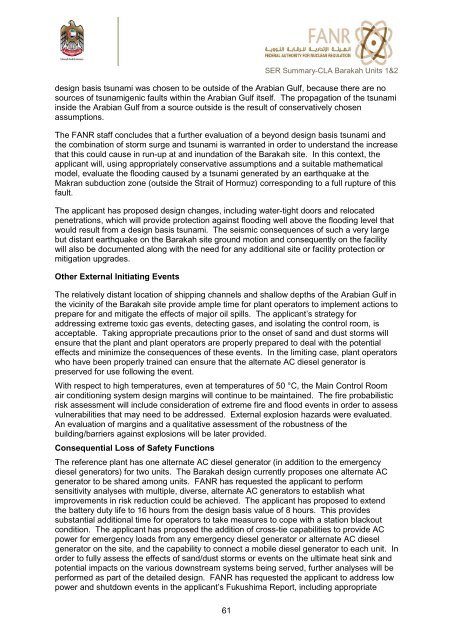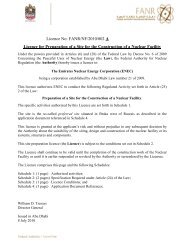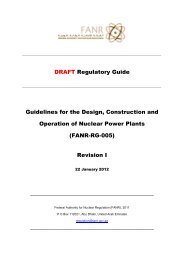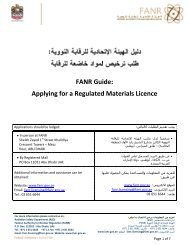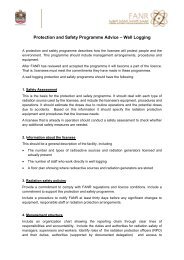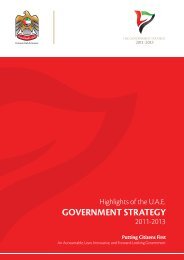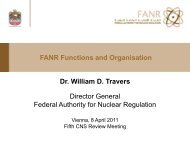Safety Evaluation Report of Barakah Units 1 and
Safety Evaluation Report of Barakah Units 1 and
Safety Evaluation Report of Barakah Units 1 and
Create successful ePaper yourself
Turn your PDF publications into a flip-book with our unique Google optimized e-Paper software.
61<br />
SER Summary-CLA <strong>Barakah</strong> <strong>Units</strong> 1&2<br />
design basis tsunami was chosen to be outside <strong>of</strong> the Arabian Gulf, because there are no<br />
sources <strong>of</strong> tsunamigenic faults within the Arabian Gulf itself. The propagation <strong>of</strong> the tsunami<br />
inside the Arabian Gulf from a source outside is the result <strong>of</strong> conservatively chosen<br />
assumptions.<br />
The FANR staff concludes that a further evaluation <strong>of</strong> a beyond design basis tsunami <strong>and</strong><br />
the combination <strong>of</strong> storm surge <strong>and</strong> tsunami is warranted in order to underst<strong>and</strong> the increase<br />
that this could cause in run-up at <strong>and</strong> inundation <strong>of</strong> the <strong>Barakah</strong> site. In this context, the<br />
applicant will, using appropriately conservative assumptions <strong>and</strong> a suitable mathematical<br />
model, evaluate the flooding caused by a tsunami generated by an earthquake at the<br />
Makran subduction zone (outside the Strait <strong>of</strong> Hormuz) corresponding to a full rupture <strong>of</strong> this<br />
fault.<br />
The applicant has proposed design changes, including water-tight doors <strong>and</strong> relocated<br />
penetrations, which will provide protection against flooding well above the flooding level that<br />
would result from a design basis tsunami. The seismic consequences <strong>of</strong> such a very large<br />
but distant earthquake on the <strong>Barakah</strong> site ground motion <strong>and</strong> consequently on the facility<br />
will also be documented along with the need for any additional site or facility protection or<br />
mitigation upgrades.<br />
Other External Initiating Events<br />
The relatively distant location <strong>of</strong> shipping channels <strong>and</strong> shallow depths <strong>of</strong> the Arabian Gulf in<br />
the vicinity <strong>of</strong> the <strong>Barakah</strong> site provide ample time for plant operators to implement actions to<br />
prepare for <strong>and</strong> mitigate the effects <strong>of</strong> major oil spills. The applicant’s strategy for<br />
addressing extreme toxic gas events, detecting gases, <strong>and</strong> isolating the control room, is<br />
acceptable. Taking appropriate precautions prior to the onset <strong>of</strong> s<strong>and</strong> <strong>and</strong> dust storms will<br />
ensure that the plant <strong>and</strong> plant operators are properly prepared to deal with the potential<br />
effects <strong>and</strong> minimize the consequences <strong>of</strong> these events. In the limiting case, plant operators<br />
who have been properly trained can ensure that the alternate AC diesel generator is<br />
preserved for use following the event.<br />
With respect to high temperatures, even at temperatures <strong>of</strong> 50 °C, the Main Control Room<br />
air conditioning system design margins will continue to be maintained. The fire probabilistic<br />
risk assessment will include consideration <strong>of</strong> extreme fire <strong>and</strong> flood events in order to assess<br />
vulnerabilities that may need to be addressed. External explosion hazards were evaluated.<br />
An evaluation <strong>of</strong> margins <strong>and</strong> a qualitative assessment <strong>of</strong> the robustness <strong>of</strong> the<br />
building/barriers against explosions will be later provided.<br />
Consequential Loss <strong>of</strong> <strong>Safety</strong> Functions<br />
The reference plant has one alternate AC diesel generator (in addition to the emergency<br />
diesel generators) for two units. The <strong>Barakah</strong> design currently proposes one alternate AC<br />
generator to be shared among units. FANR has requested the applicant to perform<br />
sensitivity analyses with multiple, diverse, alternate AC generators to establish what<br />
improvements in risk reduction could be achieved. The applicant has proposed to extend<br />
the battery duty life to 16 hours from the design basis value <strong>of</strong> 8 hours. This provides<br />
substantial additional time for operators to take measures to cope with a station blackout<br />
condition. The applicant has proposed the addition <strong>of</strong> cross-tie capabilities to provide AC<br />
power for emergency loads from any emergency diesel generator or alternate AC diesel<br />
generator on the site, <strong>and</strong> the capability to connect a mobile diesel generator to each unit. In<br />
order to fully assess the effects <strong>of</strong> s<strong>and</strong>/dust storms or events on the ultimate heat sink <strong>and</strong><br />
potential impacts on the various downstream systems being served, further analyses will be<br />
performed as part <strong>of</strong> the detailed design. FANR has requested the applicant to address low<br />
power <strong>and</strong> shutdown events in the applicant’s Fukushima <strong>Report</strong>, including appropriate


